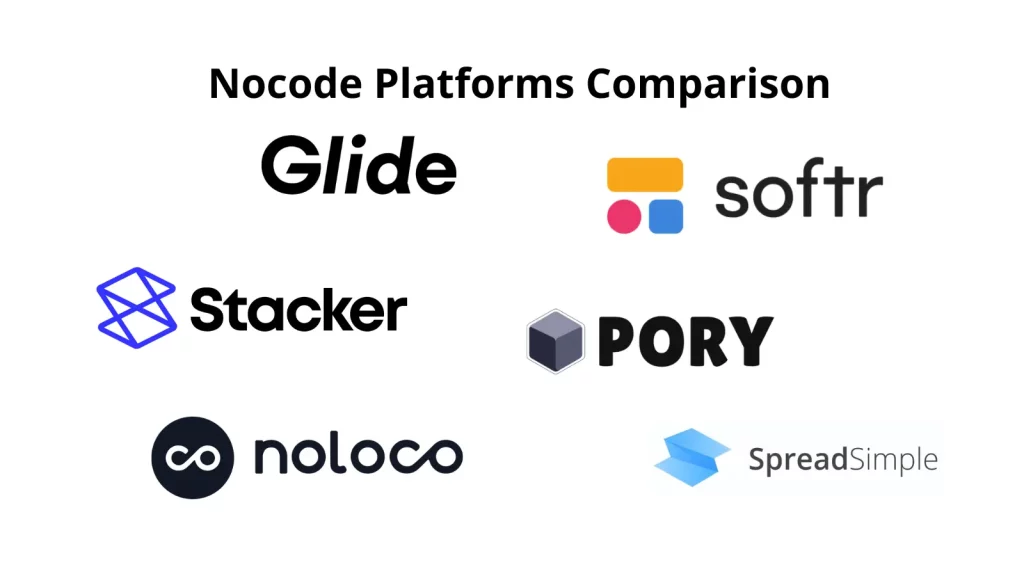Nocode Starter Guide: A Beginner’s Guide 2024
This is a short Nocode Starter Guide for learners who are looking to bring their ideas to life by building products faster.
Here’s a quick Nocode Starter Guide to help anybody who is keen on getting started with Nocode in 2024 and is looking for a Beginner’s Guide to Nocode.

What is the big deal about Nocode?
So you’ve heard of this new thing called NoCode and you’re still not sure what you can do with it?
You’re wondering if it’s for real or a joke.
At first, you didn’t take it seriously.
Then you thought: “What a cool idea. I can see why this is getting so much attention. I should probably learn more about NoCode.”
But ….
Here’s a Nocode Starter Guide
How can one get started with NoCode?
I can probably break this guide down into a few high-level things you need to do:
Picking the right platform
There are many NoCode platforms available today, but there are a few broad categories of NoCode platforms that you should know.
For simplicity, I have highlighted the most appropriate platform under each category in bold.
If you want to explore all the deals in a single place, check out this Deals page.
Nocode platforms to build Mobile Apps
- Draftbit for React native mobile apps, open source, with/without code
- Flutterflow for native mobile apps – steep learning curve
- Adalo for native mobile apps and PWAs
Nocode platforms to build Web Apps
- WeWeb [10% off for 12 months] for scalable business web apps and SaaS solutions
- Bubble for advanced SEO-friendly web and mobile apps
- Xano [10% off on all packages] for scalable backend, paired better with WeWeb & Bubble
Nocode platforms to build internal business apps
- Glide [AMIT15 – 15% off for first year] for PWAs – extremely beginner-friendly and has lots of integrations
- Noloco for internal web apps with lots of integrations
Nocode platforms to build simple SEO-friendly directories
- Ycode for stunning SEO-friendly websites and directories with Airtable as backend
- Spreadsimple for simple SEO-friendly directories
Nocode platforms to build Websites with Blog/CMS
- Framer [3 FREE months on an annual Pro plan (code: partner25proyearly)] for beautiful and SEO-friendly websites, landing pages
- Webflow for beautiful and SEO-friendly websites, landing pages – older than Framer, but with more features
- PageCloud for high performing websites, AI-powered content, custom forms, built in analytics
- Versoly for SEO-friendly websites and landing pages with blog
- Typedream for a Notion-like website-building experience
- Dorik for inexpensive website/landing page + blog builder
Nocode platforms to build Landing Pages and Websites
- Carrd for inexpensive single-page landing pages
- InstaPages for customizable landing pages for marketing campaigns
- Unicorn Platform [20% discount (code: viafirst20)] for landing pages, websites, and very basic directories
- Unbounce for landing pages that work well with paid advertising
- LeadPages for sales pages
Nocode platforms to build e-Commerce stores
- Shopify is the most popular online shopping platform
- Tradly for marketplace shopping apps
- ShareTribe is again for marketplaces
Here’s a comparison between platforms that allow you to build on top of Google Sheets or Airtable.
More specifically, here’s a comparison between Glide and Softr.
Resources to Get Acquainted with Nocode Platforms
Even before you start building your product, it would be a great idea to go through a few videos that show you around the platform.
Subscribe to the Nocode Platform’s YouTube Channel
Usually, each NoCode platform has its own YouTube channel where they have curated playlists to get you acquainted with a new thing you wish to learn. Webflow’s YouTube channel is a great example of curated playlists covering an overview of the platform, building a product for a problem statement, How To videos, etc.
Subscribe to YouTube Channels of an Expert in a particular Nocode platform
There are also NoCode platform experts who run active YouTube channels where they spill the beans about how they do certain things on the platform. Webflow, Bubble, and Glide Apps – each has such experts giving away valuable information on YouTube.
Learn by reverse-engineering Nocode templates
Once familiar with the platform, pick up the free templates from the NoCode platform’s Template library.
- Copy it to your account.
- Look under the hood.
- Get familiar with where the controls are.
- Change little things and see how the output changes.
- See how each building block is configured.
- Check each screen’s hierarchy.
List of ideas to build with Nocode platforms
Once you have selected a platform, the next step is to find ideas to build.
If you choose to build a website, pick up any website, landing page, etc. on the internet and try to build it with the platform you chose.
If you choose to build an app, the following are a few great ideas to cover a wide range of functionalities.
- Listings/Directory – an app that shows a list of things (places, wish list, people, books)
- Personal CRM – an app to build better personal relationships
- Link Tree/About.Me – an app to show links in one place
- Lead Gen Calculator – a simple calculator like a home loan, investment portfolio tracker
- To-Do List – a simple project management app
Here’s a list 15+ Custom software ideas to build with Nocode Platforms.
Here’s a list of 26 apps that I have built for my clients using Glide Apps.
Finding Help
Each NoCode platform has a thriving community where the platform experts and the platform team are helping anybody with questions. It’s a great place to learn and get inspiration from others too. Besides, the founders of each platform are listening closely to the conversations on their platform community.
If you’re still stuck, each platform has an Experts directory who you can get in touch with.
Parting thoughts on getting started in Nocode
NoCode is an exciting space. Amidst the chatter, I hope this guide helps you find your way in this jungle of information and options. It worked for me, and it may or may not work for you.
And hey!
When you build something, don’t hesitate to show it to the world.
And, if you need more motivation to get started, read how you can monetize your expertise in NoCode and build a valuable income stream.
PS: I used Copy.ai to generate the introduction of this blog post. Try it out if you liked it.
PS: This post contains a number of affiliate links. If you sign up for a service listed in this post, the service provider may choose to share a part of the revenue with me, at no additional cost to you.
